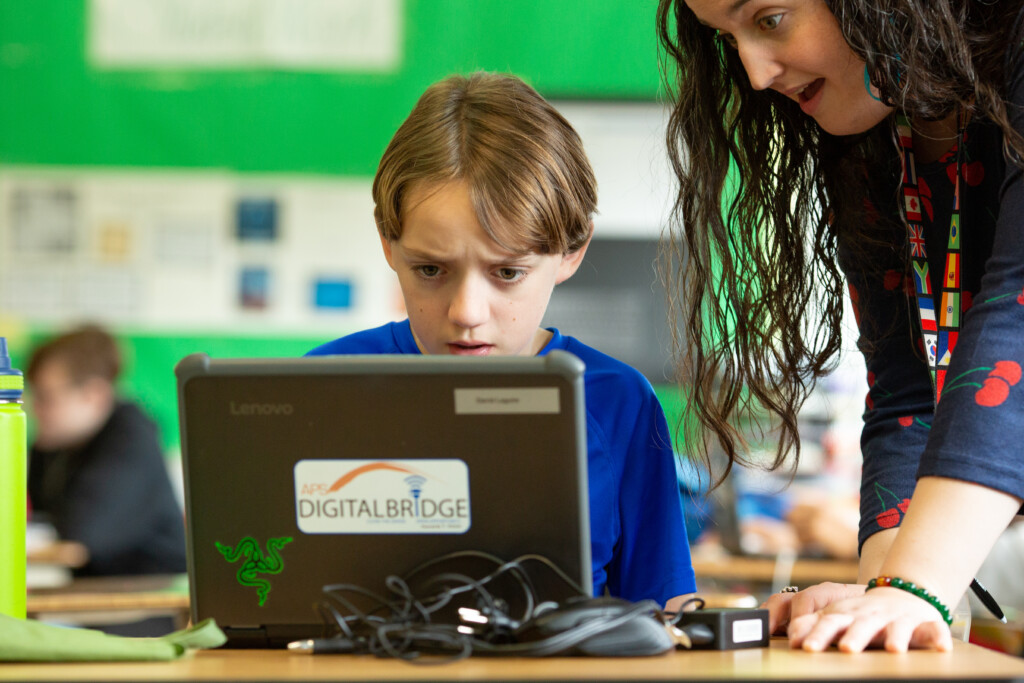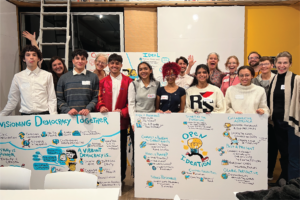Stories of AI Literacy and How to Get Started
Key Points
-
By promoting responsible AI use, we can ensure that it is used in ways that benefit students and help them develop skills that may be needed in the future.
-
Students are enjoying the collaboration with AI. For example, “It was so helpful for practicing the language. It knew my level and adjusted the questions to meet my specific needs and give additional practice. It gets you to where you need to be.”

With the increased use of artificial intelligence in the world and our classrooms, especially since the launch of ChatGPT in late 2022, it has never been more important to get students involved in learning how to use these tools ethically, responsibly, and safely. We need to promote digital literacy and, more specifically, AI literacy. As AI becomes even more common, students must understand the fundamentals of how AI works, its capabilities and limitations, and how it is being used in the world. Students’ understanding of issues such as bias, privacy, and ethics is crucial.
By promoting responsible AI use, we can ensure that it is used in ways that benefit students and help them develop skills that may be needed in the future. Think of it this way: AI is a powerful tool, and like any tool available, it requires responsible and informed users. By fostering AI literacy in our classrooms, we empower our students to navigate the information they find online and leverage the tools available to us for many different purposes, which is important.
To help educators and students, in addition to AI-powered tools for classroom use, there are special events that focus on developing AI literacy. On April 19th, the focus around the world will be on AI Literacy Day, which is designed to be a day for learning about and exploring AI. Schools and classrooms can host an event, and educators can contribute different types of curriculum materials for use with students in grades K through 12 or for after-school programs. Educators can even help build professional development resources. Through the variety of activities such as webinars, different learning events, and the lesson plans available, AI Literacy Day is a great opportunity to explore the power of AI together. Because it is being led by organizations such as EDSAFE AI, AIEDU Common Sense Media, AI for Education, and The Tech Interactive, the types of resources available will be quite helpful for educators, especially when there is some concern about the use of AI.
In May, to continue learning about AI, educators can sign up to participate in the Day of AI, happening on May 13th. Throughout the day, elementary, middle, and high school students will have access to activities and curriculum. It is a free event and will help educators get started in their classrooms without worrying about finding the resources to use. However, in preparation for these, educators can explore a few different tools, seek student feedback about the benefits, questions, or concerns they have about AI, and discuss the impact of AI in the classroom and the world.
In my classroom, whether in my Spanish classes or my STEAM course for 8th graders, we talk a lot about AI. For more than six years, I have explored various resources to help students understand how and when AI should be used. By modeling the responsible use of different tools and having students interact with AI in the classroom, we will best prepare them for the changes this technology will bring. We often have discussions about the benefits and concerns of any tools that we explore. When I choose to use something in my classroom, I consider how the tool can enhance the learning experience. I share my thoughts with students before we explore and then ask for their feedback about the experience after. I greatly value their opinions and make time to ask them about what they think and the impact. Here are some student reflections:
“It was so helpful for practicing the language. It knew my level, adjusted the questions to meet my specific needs, and gave me additional practice to help build my skills. It gets you to where you need to be.”- Antonio Boyer, 11th grade student
“The chatbot was very helpful. Immersing yourself with technology that helps you learn Spanish or any other language can help a lot. You have real-time conversations, and the chatbot expands the conversation so you can learn even more about the language. It also helps you become more comfortable speaking!” – Lily Hood, 11th grade student
“I was amazed when I submitted my response using Snorkl and instantly received feedback with comments about my speaking. It provided questions and explanations to help me understand the grammar more.” – Grace Johnson, 10th grade student
“I learned about SchoolAI, an AI website that I didn’t know about. It answered my questions in a way that kept me engaged, and it was fun! I know that AI does not have feelings, but it talked with me in a supportive and sometimes funny way to help me understand.” – 8th-grade student
AI Tools for Students
Here are some examples of the tools that I recommend and that students enjoy using. It gives them more insight into the benefits of AI and how it can be used as an enhancer rather than a replacement for doing our own work.
- Brisk Teaching: A free Chrome extension that offers four features: Create, Give Feedback, Inspect Writing, and Change Level. I have shown students how I can write something with Google and use the Give Feedback feature of Brisk to analyze my writing and receive feedback. I’ve also shown how I can quickly generate questions based on a video that we are watching in class or how I can quickly generate slides for my presentations.
- Eduaide.Ai: A platform for AI-assisted lesson planning that offers more than 100 resources to help teachers create instructional materials. Eduaide has a Content Generator, Teaching Assistant, Feedback Bot, Free-form Chat, and an Assessment Builder. I have explored Eduaide a lot to create fun activities, a project outline, gamification, and also some of the assessment builder options.
- School AI: In Spanish classes, I have used it to create a ”Sidekick,” an assistant that engages students in conversations. I prompt the chatbot to focus on specific vocabulary or grammar patterns with my students. In this case, they interact individually, and the chatbot Sidekick adapts to their needs and provides them with feedback and continued questions based on their responses. I share with students what I can see in the teacher dashboard, and it helps them understand the importance of being mindful of the interactions and the information that they share online, specifically when using any generative AI.
- Padlet AI: For a fun activity to get students thinking creatively, ask them to think about a book that they’ve read, type in the title or a description using the “I Can’t Draw” feature, and have it generate an image. The other students can try to guess. It is a fun way to teach about the power of generative AI and then have a conversation about the images that have been created or used for a speaking activity. There are lots of possibilities when it comes to using generated images as a hook for a conversation starter.
- Snorkl: An easy-to-use tool that gives students a space to talk through their thought processes while they are learning. Have students explain their learning, solve a problem, or complete any task that we give them. It records their screen and their audio and we can set it to generate AI feedback for them and then provide feedback directly to them. Students were amazed at how quickly they received feedback and how helpful it was for their learning.
Because we are seeing an increase in the presence of AI in the world and the tools available for learning and work, we need to provide opportunities for students to learn and explore them in a safe and responsible way. Trying some of these ideas and tools in your classroom will hopefully provide a fun learning experience for your students and you!






0 Comments
Leave a Comment
Your email address will not be published. All fields are required.